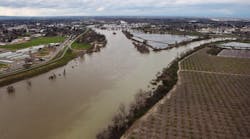On Monday, Sept. 27, New York City officials released a landmark report that helps the city prepare for and respond to extreme precipitation. “The New Normal: Combatting Storm-Related Extreme Weather in New York City,” was delivered by the Extreme Weather Response Task Force, a top-level convening of senior leaders across City agencies, along with outside experts on climate change and resiliency, to compile a new set of protocols and policies to protect against future storms like Hurricane Ida.
The city’s mayor announced plans to support the report’s recommendations with $2.1 billion in new funding for the Department of Environmental Protection (DEP); $238 million in accelerated funding for crucial DEP projects; $400 million in new funding for other priority capital projects among key agencies including the Parks Department; Department of Transportation; NYCHA; and the School Construction Authority; and $25 million in expense funding for Fiscal Year 2022.
“Extreme weather is more common than ever, and more severe than ever. Business as usual is over. Keeping New Yorkers safe means profoundly changing the way we prepare for – and react to – this new normal,” said Mayor Bill de Blasio. “This new report charts a path forward for investing in vulnerable neighborhoods, shoring up our infrastructure, warning communities ahead of major weather events, and better tracking storms before they arrive. I’m proud to share it with New Yorkers, and I look forward to forging a safer and more resilient city.”
The city is also creating its first “Rainboots on the Ground” program – the city’s first-ever distribution of educational information on evacuation procedures for basement apartment residents and vulnerable neighborhoods. Starting in 2022, the City will contract with 60 community-based organizations to canvass these neighborhoods and highlight the threats posed by stormwater and extreme weather.
The mayor also announced the creation of a new Extreme Weather Coordinator position in City Hall. The position will work closely with New York City Emergency Management (NYCEM) and other agencies to lead and organize extreme weather response. Starting immediately, Deputy Mayor for Administration Emma Wolfe will be the first to serve in this role.
“New Yorkers have seen the effects of extreme weather on their communities, and they know it’s happening more frequently than ever before,” said Deputy Mayor for Administration Emma Wolfe. “Thanks to targeted investments and better storm tracking, New York City will be more prepared than ever to keep the city safe from extreme weather.”
“The New Normal” outlines detailed new strategies to:
- Educate and acclimate New Yorkers to growing storm prevalence
- Increase planning for worst-case scenarios
- Accelerate upgrades to storm modeling, tracking, and alert systems
- Broaden protection for inland communities
- Protect basement and cellar occupants
- Prioritize investments in low-income neighborhoods, immigrant communities, and communities of color
- Re-imagine the city’s sewage and drainage system,
- Rapidly increase green infrastructure and cloudburst solutions
- Call on support from the state and federal government
“A collaborative team of researchers at the City University of New York (CUNY) and New York University (NYU) has demonstrated the utility of flood sensors to collect accurate, local, real-time information about street flooding in New York City during events like Ida,” said Brett Branco, Director of CUNY’s Science and Resilience Institute at Jamaica Bay located at Brooklyn College and a member of the FloodNet sensor team. “This technology and its applications developed in collaboration with communities and city agencies is an essential component of the comprehensive strategy presented in the Extreme Weather Response Task Force report, and will help prepare NYC for future extreme weather events and rising sea levels.”
"As co-authors of the framework, the Natural Areas Conservancy is thrilled that Mayor de Blasio and his administration have endorsed the Wetlands Management Framework for New York City in their latest efforts to improve the city's resilience to climate change. Understanding and investing in our natural areas should be an important part of our response to the climate crisis, and this is a crucial step in the right direction. By adopting the Wetlands Management Framework, the city is showing its commitment to properly investing in New York City’s hydrological infrastructure — infrastructure that will play an outsized role as our city continues to experience flooding and extreme weather events as a result of climate change,” said Sarah Charlop-Powers, Executive Director, Natural Areas Conservancy.
SOURCE: New York City Department of Environmental Protection



